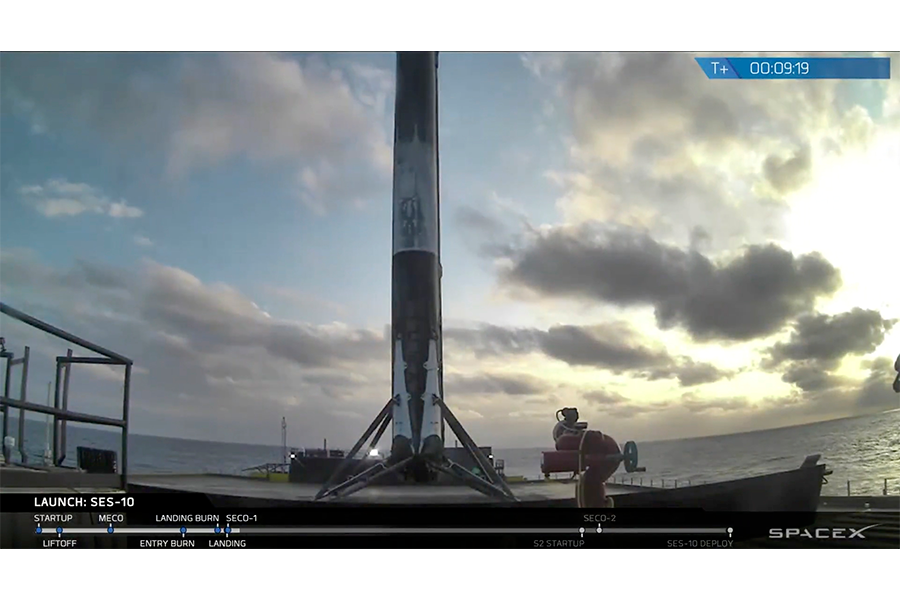SpaceX makes history twice in one evening
With two landmarks for the price of one, the frugal rocket company SpaceX economizes even its history making.
Space Exploration Technologies Corp., as the company is officially known, launched into orbit a communications satellite atop a pre-flown booster rocket, and then landed it on an autonomously floating landing pad in the Atlantic Ocean on Thursday. No organization has ever flown an orbital rocket twice, much less brought it back for a second landing. The achievement heralds a new era in spaceflight, some say.
Among them is SpaceX’s founder and chief executive Elon Musk. "This is a huge day. My mind's blown, frankly," Mr. Musk said, according to the Associated Press. He called it an "incredible milestone in the history of space" and predicted, "this is going to be a huge revolution in spaceflight."
The satellite belonged to Luxembourg communications company SES, whose chief technology officer Martin Halliwell called the mission "a big step for everybody - something that's never, ever been done before."
Previously, booster rockets with their expensive and high-tech engines have been abandoned to plummet into the ocean, a waste Musk has likened to flying a Boeing 747 just once before dropping it into the sea. He says the need to assemble a new rocket for each launch is a key reason spaceflight costs remain astronomically high, which in turn prevents consumer demand from developing a market that can bring economies of scale to rocketry.
Now, the ability to reuse rockets could change everything. “The potential is there for (an) over 100-fold reduction in the cost of access to space. If we can achieve that, it means humanity can become a space-faring civilization and be out there among the stars. This is what we want for the future,” said Musk, according to Reuters.
As of Thursday, SpaceX has successfully landed 9 out of 14 boosters, 3 on land and 6 at sea. The 15-story booster houses nine engines and represents the most expensive part of the rocket, up to 75% of the costs. A one-engine second stage that boosts the payload into orbit after the booster falls away remains unrecoverable. Thursday’s mission also saw the recovery of another rocket part: the Falcon's $6 million satellite enclosure, which used thrusters and parachutes to drop safely into the Atlantic.
But don’t expect Kayak to start indexing rocket trips just yet. While SpaceX eventually hopes to slash launches by about a third (from $60 million to $40 million), first they have to recoup research and development costs to the tune of $1 billion, which Musk says will take about a year. Neither company has confirmed the price paid for the launch, but SpaceX has previously floated the idea of a 10 percent discount for early flights on recycled rockets.
Both companies are quick to point out that when it comes to space, reliability can be the most valuable attribute. "You've got to get away from the idea that it's secondhand," Mr. Halliwell told reporters, according to the AP. "Flight proven," Musk added, his preferred term.
Other companies are chasing the dream of reusability as well. While SpaceX focuses on government contract supported orbital flights, Jeff Bezos’s Blue Origin is taking aim at cracking open the space tourism market with (comparatively) short suborbital hops, for which it has already demonstrated the ability to re-fly rockets.
Legacy rocket companies such as United Launch Alliance have also considered reusability, but concluded that the complicated economics of adding extra fuel for the return and refurbishing made the idea infeasible for just a handful of flights per year. Other space agencies have estimated one would need to fly 30 to 50 rockets annually before seeing a substantial impact to the bottom line. Implicit in SpaceX and Blue Origin’s plans is the build-it-and-they-will-come assumption that a sizeable untapped demand for space access will drive a low cost, high launch frequency business model.
Looking toward that future, Musk specified the company’s next short term goal: re-launching a booster within 24 hours, which he expects to pull off by the end of the year.
In the mid to long term, SpaceX’s plans don’t get any less ambitious. Next year it hopes to finally realize its oft-delayed goal of ferrying astronauts to and from the International Space Station, while simultaneously preparing to fly two as yet unnamed space tourists around the moon. Uncrewed Mars missions are also in the works for the early 2020s, and Musk’s stated objective is to eventually establish a colony on the Red Planet.
This report contains material from Reuters and the Associated Press.






